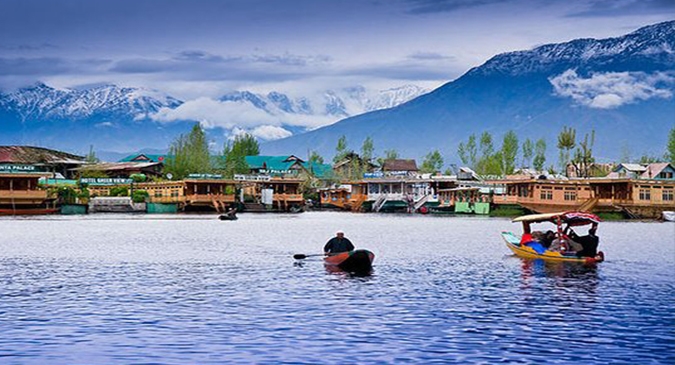Introduction to Kashmir
Total Views |

Kashmir:
Currently Kashmir is the most talked about region of India. However, it is a fact that most of the people talk about Kashmir, without even knowing the state, the history and geography of the state. Another very common and major blunder committed by people is that they address the entire state of Jammu and Kashmir as Kashmir, oblivious of the fact that Kashmir is just one of the parts of this ancient, large and diverse state, and that too the smallest part. Hence, it is important to know that the state of Jammu and Kashmir has three parts, Laddakh, Jammu and Kashmir.
Geography:
There are three valleys in Kashmir region, namely Kashmir, Gurez and Lolab. The Kashmir valley is in the shape of a bowl and it has ten districts. It has people who are called Kashmiri and Gujar. The Gurez valley has population called Sheena and Lolab valley has Kashmiri and Pahadi population. It is interesting to note that Gurez valley in Bandipura district, is spread over about 2000 sq. km. and it has no cultural connect with Kashmir valley because it was part of the Gilgit region, illegally occupied by Pakistan since 1947.
Rivers:
There are some big and several small rivers in Kashmir valley.
The name Anantnag owes its origin to the words Anant- meaning endless or countless Naga- denoting natural water sources springs, curled up like snakes. It is these springs and tributaries which charge the Jhelumriver, however, Verinag is the source of Jhelum.
Major tributaries, like the Liddar, Kishenganga, the largest tributary from Gurez valley, Chhota Sindhu- originating at Sonmarg glacier and merge with Jhelum at Shadipora sangam.
This is a pilgrimage destination for the Hindus and there are annual festivities on the line of Kumbh Mela here.
Besides the rivers there are extremely beautiful lakes in Kashmir. Whoever visits Kashmir, also visits the Dal lake and feels content. Although the fact is that the Dal lake is over explored and visited. There are many more lakes with breathtaking beauties. To name a few:
Wular lake which is Asia’s biggest lake in Bandipura district and Manasar Lake.
Very few know about the wooden canal built by the Maharaja in Kashmir, the 2nd Canal in the world. This was for the first ever Hydro Project in Kashmir. It was necessary to draw water up between Uri and Baramulla and for this purpose the wooden canal was built and finally electricity was generated in Srinagar.
In 1947, when the Pakistani army attacked Jammu and Kashmir, it caused serious damage to the canal and since then it has remained neglected by the administration. The first wooden canal of India has great heritage value.
People and Culture:
As mentioned above, the state of Jammu and Kashmir has very diverse culture. Even this part of the state has a variety of cultures and dialects, denoting distinct identity of its inhabitants. For example, in the Gurez valley the population is Sheena and speaks Sheena dialect, in Lolab spoken dialects are Kashmiri and Pahadi, and the inhabitants are also known by the same names. In Kashmir valley the common dialects are Kashmiri, Pashto,???
Historically speaking Kashmir was the center of education and the seat of Shaivaite sect/philosophy of Hinduism. The scholars from Kashmir were famous in the entire country and it was believed that unless one participates in the Shastrarth- a philosophical and religious debate, with a Kashmiri Pandit, his education and expertise were incomplete.
Such was the reverence for Kashmir and the Kashmiri Pandits, that if one could not travel to Kashmir, after finishing education, he would walk seven steps in the direction of Kashmir to complete it.
Temples
Martand Sun Temple in Anantnag, built in 8th Century CE and was destroyed by Sikandar Butshikan in 15th Century and the demolition process lasted for almost one year
Avantipura Temple in Pulwama another abcient Temple built in 9th Century is a symbol of our rich heritage.
Detha devi temple in Uri, these are in complete ruins, many such temples which are destroyed and are in ruins today.
Kashmir is much more than Gulmurg, Sonmarg or such few select destinations popular among tourists. There is beauty, heritage, culture and history in every nook and corner of this region. The Indian heritage has deep roots here and the ruins of temples and cultural heritage speak volumes about our past.
Unexplored areas of Kashmir for tourism are-
- Gurez valley- Originates from the Sheena word Gau-Hari, grazing place for Cows. The beauty of the Gurez valley is mesmerizing. The best time to visit Gurez is between May to October, as for the rest of the months it is covered with snow. Gurez valkley has an area of about 2000 sq km and it is part of Gilgit and not of Kashmir.
- Lolab valley – is famous for its meadows. It also has several varieties of fruits and is also called the fruit bowl of Kashmir.
- Dodhpathri- The less explored tourist destination is in Budgam district. It is popular for the pine tree forest and the high meadows.
Other than these there are several tourist destinations gifted with astonishing beauty.
In order to understand Jammu and Kashmir one must know it’s history, heritage and culture, which is of great significance and value. This is our heritage which must be passed on to our future generations and hence it must be preserved and protected.

